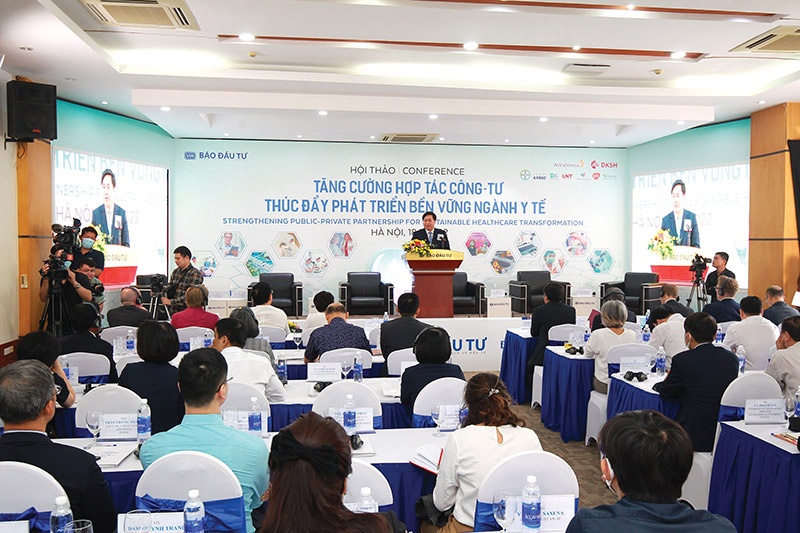More favourable rule system urged for healthcare PPPs
 |
| Speakers at last week’s conference noted that dozens upon dozens of multinationals are interested in the healthcare PPP model in Vietnam. Photo: Chi Cuong |
At last week’s conference on the issue, hosted by VIR, Deputy Minister of Planning and Investment Tran Duy Dong said that Vietnam’s healthcare sector is facing a number of big issues, including rising infectious and non-communicable disease figures, hospital overload, and an ageing population. The pandemic has also revealed some weaknesses in the sector.
“To further improve healthcare service quality and meet demand, mobilising financial resources for new development of infrastructure and medical equipment is a key requirement,” he noted.
For the past five years, the government has looked to strengthen the implementation of a model for public-private partnerships (PPPs) for the public sector, including in healthcare services. However, according to VIR’s editor-in-chief Le Trong Minh, the picture of such investment in the sector is yet to meet expectations.
“To increase its sustainability and resilience to better respond to future health crises towards the development of sustainable healthcare, it requires innovation in private attraction, as well as stronger cooperation from all stakeholders, with PPP being among the solutions,” Minh added. “Clear legal guidance is an urgent need to promote it in the new normal.”
At the event, participants discussed ways to mobilise private funding in the sector and solve existing legal barriers. Torben Minko, vice chairman of the European Chamber of Commerce in Vietnam (EuroCham), elaborated that the country has a promising opportunity for PPP development, with a dynamic population, increasing middle-income class, and also a rising need for high-quality products and services.
“Currently, PPPs are not yet applied in the service area. Service-based PPPs can unlock further contributions from the private sector towards an inclusive, forward-looking, and sustainable healthcare system for the benefit of Vietnamese people,” Minko said. “As such, a legal framework is the key that is conducive for business via a predictable and sustainable environment.”
The Law on Public-Private Partnership Investment, which took effect last year, creates more favourable conditions for sectors to develop the PPP model, thus increasing their efficiency and reducing cost, with one of the advantages being including healthcare among the prioritised sectors.
However, according to the Ministry of Planning and Investment, the healthcare sector has yet to lure any new PPP projects since 2019. At present, this type of funding in the healthcare sector mostly focuses on several cities and provinces such as Hanoi, Ho Chi Minh City, Haiphong, Danang, Quang Ninh, Quang Nam, Ca Mau, and Ben Tre.
Regarding a future strategy, Minko added, “We would hope for a more forward-looking PPP legal framework, especially for healthcare and integration into the National Healthcare Financing Strategy. To encourage more investment from EuroCham member companies in the sector, we propose an examination of the model for healthcare and provision of diverse and feasible socialisation models.”
As soon as possible, Minko said, relevant ministries should be able to issue official documents of consistent policy regarding the model of placing equipment in public health establishments, in order to create an open and transparent legal framework.
Luke Treloar, partner at KPMG in Vietnam said, “If Vietnam can legalise its existing regulations, the room for development remains big in the future.”
According to EuroCham, 60 multinational corporations operating in healthcare and pharmaceutical companies are interested in developing the PPP model in this country.
Phuong Le Tri, chief medical officer at AstraZeneca Vietnam, said a sustainable healthcare system would help improve people’s health conditions and minimise the negative impact on the environment, thus protecting the whole community as well as the planet.
“The pandemic has taught us a great lesson about sustainability and resilience of the healthcare system. Besides sustainability, we need to promote digital transformation to increase people’s access to healthcare, while intensifying grass-root health facilities to overloads at central hospitals,” Tri said. “Our future solutions and development trends are to mitigate environmental impacts.”
For DKSH, it foresees several key trends in digital transformations for sustainable healthcare (see Page 20). Phillip Alexander Wray, general manager of DKSH Pharma Vietnam, explained, “In many of the countries that we operate in across Asia, DKSH has been leveraging cloud computing to develop and continue to upgrade integrated solutions to help pharmacies, clinics, and healthcare facilities easily monitor stocks, place orders, track deliveries, make payment, and carry out instant financial reconciliation at their fingertips.”
| Tran Duy Dong - Deputy Minister of Planning and Investment
Vietnam is facing the requirement of changes, expansion, and strengthening of the healthcare network. Quality of care and patient satisfaction has improved in recent years. However, worries remain about facilities and costs. Through communication channels, people expressed their concerns about infrastructure conditions in hospitals, especially at the provincial and district levels. In order to improve the quality of the health sector, mobilising financial resources for new investments in infrastructure and equipment is very important. In many countries around the world, the application of public-private partnerships (PPPs) to the construction of works in the health sector has contributed remarkably to the process of solving the problem of the shortage of capital resources mentioned above. In Australia, the health sector’s construction investment in the form of PPP has contributed to cutting down over-budget costs to 4.3 from 18 per cent. In Turkey, the management of construction investment in the form of PPP has met the needs of people. Specifically, Turkey is looking to ensure an additional 90,000 hospital beds by 2023. In Vietnam, the Party also highlights the promotion of PPP investment methods in public services, especially in health services as stated in Resolution No.19-NQ/TW from 2017: “It is necessary to continue implementing the mechanism of public-private combination in human resources and branding in the health sector; building investment cooperation mechanism between public and private hospitals, and among public hospitals.” The Party’s policy and views on the mechanism to attract private human resources to infrastructure development have been concretised in formulating the Law on Public-Private Partnership Investment. Based on the inheritance of good regulations being implemented and adding new contents to investment, the law has created a more stable legal environment for related projects, strengthening the confidence of investors and businesses, especially foreign ones. Thereby, the resources of the private sector will be lured and utilised effectively to make up for the shortfalls of the state budget in infrastructure investment and public services; creating a new impetus to promote the country’s economy and society for sustainable development in the next stages; creating a premise for implementing more PPP projects in social security, especially in healthcare. However, the implementation of the Law on Public-Private Partnership Investment still struggles with limitations. Projects are implemented mainly in key areas such as transportation, energy, clean water supply, wastewater and waste treatment. Some areas are under regulations but have not yet been implemented or have not been applied successfully such as agriculture, healthcare, education, culture, sports, and economic zone infrastructure. According to statistics from the World Bank, 58 projects on the list of related projects in the health sector in 2019 were proposed. However, only 13 of these have reached the pre-feasibility study, six reached the feasibility study, five are in the bidding process and contractor selection, and two projects have signed a contract. PPP schemes in the health sector are mostly concentrated in such cities and provinces as Hanoi, Ho Chi Minh City, Haiphong, Danang, Quang Ninh, Quang Nam, Ca Mau, and Ben Tre. Despite being a promising land, there are not many investors in this sector. Since 2019, there have been no more projects created in the form of PPP in the health sector. Therefore, reviewing the policy framework for implementing these ventures is quite essential to identify opportunities and challenges in the implementation of the model in the sector at present. With the efforts of all of us, including state management agencies, associations, experts and the business community, I believe that the goal of promoting PPP for a sustainable health sector in Vietnam will achieve great success, contributing to improving the productivity, quality and competitiveness, and contribute to socioeconomic development. Vu Quynh Le - Deputy director general Public Procurement Agency, Ministry of Planning and Investment
The Law on Public-Private Partnership Investment took effect in 2021 and its guiding documents have also been issued, as well as a drafted circular on the implementation of related projects in the healthcare sector. PPP investment in this sector is applied to projects with a minimum scale of VND100 billion ($4.35 million) in the fields of medical examination and treatment facilities, preventive medicine, and testing facilities. PPPs in medical projects have potential. Decree No.19-NQ/TW dated 2017 emphasised implementing the PPP mechanism in terms of human resources and branding in the health sector, as well as building cooperation mechanisms between public and private hospitals, and among public hospitals. In the PPP model, investors can enjoy much more advantages than normal private projects, including incentives in terms of taxes, land use fees and land rental, and more; and an investment guarantee ensuring the right to access and use land, other public assets, the right to mortgage property, the right to operate construction works, and infrastructure. Moreover, the surplus or deficit in operations and doing business in PPP projects will be shared between the public and private sectors. In another way, the privatisation of health projects is suitable for short-term contracts in that investors can recoup investment capital soon, for example, in a single tenure of the hospital’s director. There are some advantages of privatisation in health, including fast project preparation and various forms of partnership such as joint ventures, affiliations, capital raising, and asset leasing. However, they are weak in accountability and mechanisms to bind obligations among parties, and there is still a lack of clarity in the private investor selection process. Nguyen Huy Quang - Former director Legal Department, Ministry of Health
To encourage the participation of the private sector in healthcare development, firstly, it is necessary to create a fair and equal playing field between the private and public health sectors, ensuring impartiality in the institutions and enforcement process in Vietnam. Secondly, it is necessary to further invest in the digital transformation of infrastructure, sharing information about medical records between the public and private sectors, and also creating conditions so that people can receive medical examinations and treatment. Third is ensuring no stratification exists between rich and poor patients is also important, allowing the poor to access quality private hospitals. Private hospitals are now very focused on hospital administration and brand identity; the public sector should learn in this regard. Fourthly, the public hospital sector has a better quality of human resources, while the private sector has better quality machinery. How the private sector can train and improve human resources, with the shift of human resources to create a balance between public and private healthcare sectors, is an issue that needs attention. In addition, the health sector needs to respond to Industry 4.0, including digital transformation and innovation, cooperating with the Ministry of Public Security in national data integration, and electronic medical record popularisation, helping to integrate medical records among medical treatment units nationwide. It is also necessary to encourage the development of telemedicine, including telemedicine consultation and remote support, along with ensuring better practitioner management. Ingo Brandenburg - General director, Bayer Vietnam
I am very happy to be back in Vietnam after a few years and see the dynamic and rapid development of the country, especially in the healthcare sector. The pandemic has proven that health is, and will certainly continue to be, a priority for people. As a global leader in healthcare and nutrition, we put sustainability at the centre of our corporate vision “Health for all, hunger for none”. In healthcare, Bayer commits to improving people’s health and wellbeing with our innovative products and solutions, making our existing products and services accessible and affordable, systematically advancing innovations and increasing the resilience of our production and supply chains. Now more than ever, progress cannot be achieved without partnerships. As such, we actively collaborate with NGOs, governments, and public and private organisations to expand access to healthcare for all. We trust that the focus on sustainability and PPPs in Vietnam’s national strategy has moved the health sector in the right direction to ensure broad access to quality treatment in the context of growing healthcare needs in Vietnam. Going forward, our priorities will continue to be placed on addressing the unmet needs of the vast patient and consumer base through our innovative portfolio; putting more resources on the frontlines to educate, detect, and treat conditions early; and contributing to the digital healthcare ecosystem to drive more effective and convenient access and solutions for patients and physicians. Ensuring timely patient access to the necessary medicines will also require multi-stakeholder collaboration, which includes support from government agencies on regulatory and administrative facilitation to support the registration of innovative products and make them timely available for patient access in the market. The pandemic could be the witness of multi-stakeholder collaboration for the availability of vaccines as well as non-pandemic chronic medicines so that patients could benefit from continual treatment as required. Looking forward, a well-coordinated and systematic approach among ministries and key stakeholders at different levels would be crucial to facilitate a holistic master plan for local healthcare development – from building infrastructures and increasing capacities to creating an ecosystem where public and private sectors have pivotal roles to play. This will subsequently help increase Vietnam’s competitiveness, bringing more confidence in investors to not only meet the growing local healthcare demands but also to realise the ambition of the country to become a regional hub for innovation and high-quality healthcare services. Luke Treloar - Partner, KPMG in Vietnam
The development of brand-name drugs among stakeholders in Vietnam brings diverse benefits to patients, including broader access to more effective medicines, improved outcomes and less time in the hospital, and reduction of the overall cost of care, so that more patients can receive more high-quality treatment. Economies that have successfully transitioned from basic manufacturing into complex medical manufacturing have embraced innovation and international best practices. So, I would recommend that the government looks to tax incentives and streamlining regulations to help encourage foreign direct investment and more participation from multinationals in pharmaceuticals. Even though Vietnam has a young population, it is ageing very rapidly. It also has a very high number of out-of-pocket ratio, which means that as Vietnam transitions from a communicable disease market to a non-communicable one, it may struggle to afford its own medicine. To accelerate this, we recommend that Vietnam embraces private sector development, alternative financing for healthcare such as private wrapper programmes or insurance policies, and other types of innovative financial models. The biggest barriers in Vietnam are time and regulations. Foreign companies want to participate in Vietnam and localise clinical trials or other policies and practices. There is an opportunity for global multinational pharmaceutical companies to spend as much as 2 per cent of global research and development here in Vietnam. They want to do that, but it’s still challenging to set up clinical trials and set up new businesses. So, if Vietnam can streamline its regulations, there’s a lot more to come. Nguyen Thanh Son - Founding investor, Doctor Anywhere
In order to create sustainable development, the health sector should focus on ensuring quality of life and equality in approaching healthcare services. For example, in Singapore, Thailand, and Malaysia, healthcare services will have a trend to connect with each other to create an ecosystem. In order to complete this ecosystem, the application of digital plays a crucial role. This revolution will target reducing expenditures and service fees, simultaneously improving the capacity to approach services and people’s awareness about taking care of health. Promoting the application of digital tech all starts with mindset. Limited digital capabilities of health professionals and patients are a challenge for Vietnamese hospitals. The current focus of software integration is still too focused on short-term goals. Although tech investments are approved by management, real users of the tech are doctors, nurses, and operational staff, and hesitance and inability from these users will slow down adoption. |
What the stars mean:
★ Poor ★ ★ Promising ★★★ Good ★★★★ Very good ★★★★★ Exceptional
 Tag:
Tag:
Themes: Healthcare Platform
- DKSH to acquire Vietnamese healthcare distributor Biomedic
- Two national hospitals expand capacity with new facilities
- Vietnam moves to enhance disease prevention, equity, and sustainability
- Vietnam unites to tackle major causes of disease and death
- Health Innovation Hub: accelerating health equity through digital healthcare innovation
Related Contents
Latest News
More News
- Vietnam's top 500 value-creating enterprises announced (December 27, 2025 | 08:00)
- The PAN Group shaping a better future with ESG strategy (December 26, 2025 | 09:00)
- Masan Consumer officially lists on HSX, marking the next phase of value creation (December 25, 2025 | 13:20)
- MCH to become the largest consumer stock on VN-Index (December 24, 2025 | 11:05)
- Oil and gas firms post strong 2025 results (December 22, 2025 | 17:42)
- SABECO wins multiple international beer awards (December 22, 2025 | 17:41)
- UOB sees Vietnam growth easing in fourth quarter (December 22, 2025 | 17:39)
- First members of Danang International Finance Centre revealed (December 22, 2025 | 17:39)
- Human-centred governance seen as key to AI development (December 19, 2025 | 18:19)
- Top 10 notable events of Vietnam’s industry and trade sector in 2025 (December 19, 2025 | 14:00)






























 Mobile Version
Mobile Version